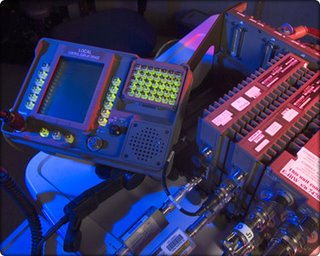


|

|
|
|
Home |
The Mil & Aero Blog
 Posted by John Keller SAN DIEGO -- Military radio designers need to give more thought to how they blend RF and microwave components with digital circuitry in new generations of software-defined radio, says one of the Pentagon's top communications executives. The problem revolves around radio designs that tightly couple the RF section and digital sections. This can slow down design and production, and create huge headaches when it comes to technology insertion and systems upgrades, says Dr. Ron Jost, the DOD's deputy assistant secretary of defense for C3. "Please don't tightly couple the RF to the digital sections in the radio," Jost said today in a keynote address at the Military & Aerospace Electronics Forum (MAEF) conference and trade show in San Diego. "The RF won't change much; it's the digital that will change." In the interests of full disclosure, I need to point out that the MAEF is sponsored by Military & Aerospace Electronics magazine. Jost told MAEF attendees that digital circuitry goes obsolete very quickly -- as often as once a year -- and tightly coupling the RF to digital often is problematic. Instead, Jost suggests that radio designers create more modular communications architectures where digital circuitry easily can be swapped out as it goes obsolete, but that leaves the longer-lasting RF and microwave sections alone. Evidently this is among the reasons that the Pentagon's Joint Tactical Radio System (JTRS) program is in trouble. Radio designs are not the only problems facing the Pentagon's communications planners, Jost points out. Senior Defense Department planers are well along in network management, yet what they need now is spectrum management. He's asking for the defense industry's help to do this. "We are going to put together a complete spectrum-management tool and network-management tool for the Department of Defense, and we need your guys's help," Jost told MAEF attendees this morning. "The warfighter can't do it with what we're giving him today." 0 Comments:
<< Home |
Welcome to the lighter side of Military & Aerospace Electronics. This is where our staff recount tales of the strange, the weird, and the otherwise offbeat. We could put news here, but we have the rest of our Website for that. Enjoy our scribblings, and feel free to add your own opinions. You might also get to know us in the process. Proceed at your own risk. 
John Keller is editor-in-chief of Military & Aerospace Electronics magazine, which provides extensive coverage and analysis of enabling electronic and optoelectronic technologies in military, space, and commercial aviation applications. A member of the Military & Aerospace Electronics staff since the magazine's founding in 1989, Mr. Keller took over as chief editor in 1995.  Courtney E. Howard is senior editor of Military & Aerospace Electronics magazine. She is responsible for writing news stories and feature articles for the print publication, as well as composing daily news for the magazine's Website and assembling the weekly electronic newsletter. Her features have appeared in such high-tech trade publications as Military & Aerospace Electronics, Computer Graphics World, Electronic Publishing, Small Times, and The Audio Amateur.
Courtney E. Howard is senior editor of Military & Aerospace Electronics magazine. She is responsible for writing news stories and feature articles for the print publication, as well as composing daily news for the magazine's Website and assembling the weekly electronic newsletter. Her features have appeared in such high-tech trade publications as Military & Aerospace Electronics, Computer Graphics World, Electronic Publishing, Small Times, and The Audio Amateur.
 John McHale is executive editor of Military & Aerospace Electronics magazine, where he has been covering the defense Industry for more than dozen years. During that time he also led PennWell's launches of magazines and shows on homeland security and a defense publication and website in Europe. Mr. McHale has served as chairman of the Military & Aerospace Electronics Forum and its Advisory Council since 2004. He lives in Boston with his golf clubs.
John McHale is executive editor of Military & Aerospace Electronics magazine, where he has been covering the defense Industry for more than dozen years. During that time he also led PennWell's launches of magazines and shows on homeland security and a defense publication and website in Europe. Mr. McHale has served as chairman of the Military & Aerospace Electronics Forum and its Advisory Council since 2004. He lives in Boston with his golf clubs.
Previous Posts
Archives
|
|||||
|
THE MAE WEBSITE AUTHORS ARE SOLELY RESPONSIBLE FOR THE CONTENT AND ACCURACY OF THEIR BLOGS, INCLUDING ANY OPINIONS THEY EXPRESS, AND PENNWELL IS NOT RESPONSIBLE FOR AND HEREBY DISCLAIMS ANY AND ALL LIABILITY FOR THE CONTENT, ITS ACCURACY, AND OPINIONS THAT MAY BE CONTAINED HEREIN. THE CONTENT ON THE MAE WEBSITE MAY BE DATED AND PENNWELL IS UNDER NO OBLIGATION TO PROVIDE UPDATES TO THE INFORMATION INCLUDED HEREIN.
|
||||||
|
|
Home | About Us | Contact Us | Corporate Website | Privacy Policy | Courage and Valor Foundation | Site Map
Also Visit: Laser Focus World | Vision Systems Design | Industrial Laser Solutions Copyright © 2007: PennWell Corporation, Tulsa, OK; All Rights Reserved. | Terms & Conditions | Webmaster |